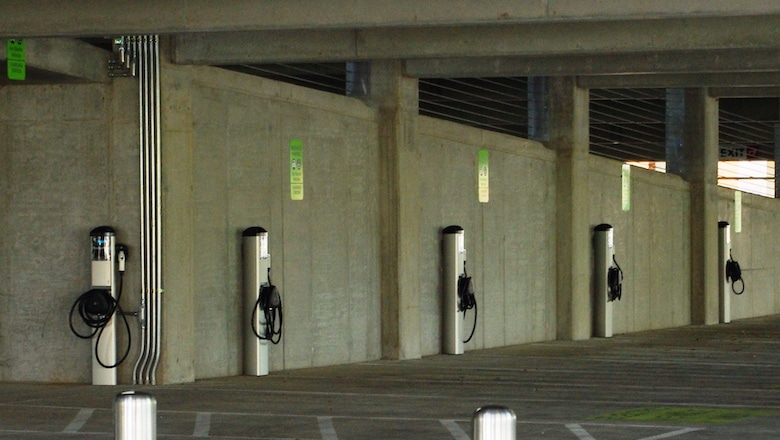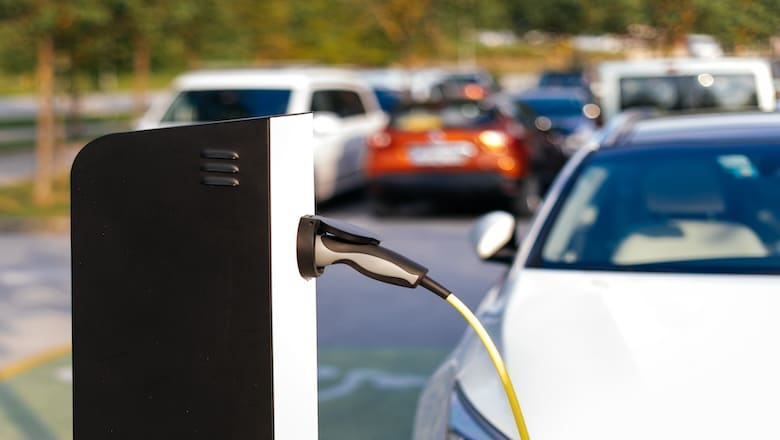The future is electric: planning ahead when installing EV charging stations
Is your facility ready for the future of electric vehicles? Now is the perfect time to find out. Projects may be eligible for 100% of infrastructure upgrade costs through utility incentive programs—and GreenerU is here to help you navigate the whole process.

The U.S. Environmental Protection Agency has a greenhouse gas equivalencies calculator that we reference often when trying to visualize what a metric ton of carbon dioxide equivalent might look like. (Turns out it doesn’t look like a giant one-ton weight.)
One of the interesting equivalencies that pops up is “number of gas-powered passenger vehicles driven for one year.” That metric requires a couple of other calculations—11,520 miles driven, for example, which is the national average—and 522 gallons of gas consumed.
But what these equivalencies may not drive home is the impact of transportation on the environment. Emissions from vehicles—whether Scope 1 from your institution’s vehicular fleet or Scope 3 from commuters—are some of the largest contributors to greenhouse gas emissions in the United States. The transportation sector accounted for 29% of total U.S. greenhouse gas emissions in 2019, and light-duty vehicles made up 58% of those emissions.
A possible solution, the electric vehicle market, has stepped up its game within the past 15 years, starting with the introduction of the Tesla Roadster followed by a series of fully electric vehicles with rechargeable batteries. As federal and state incentives continue to stimulate the market for both electric vehicles and the infrastructure that supports them, fully electrified transportation is just over the horizon.
When it comes to electric vehicles themselves, options abound—and not just for personal use. Electric buses, electric fire trucks, even electric ambulances are coming on the market. But for any of these vehicles to function successfully, they need charging stations.
That’s where GreenerU comes in.
Market trends
GreenerU is helping customers install EV charging stations in parking lots and garages at their facilities, in anticipation of an increasing demand on the part of staff and visitors who will be part of a nationwide transition to electric vehicles.
That trend has already started. California has a goal of phasing out the sale of new gas-powered vehicles by 2035, starting with a goal of 35% of all vehicle sales to be electric by 2026. That’s a major jump from today, where just 12.4% of California’s annual vehicle sales are electric. This move on the West Coast will almost certainly shift the market, as manufacturers will try to keep up with demand in the nation’s most populous state.
And while national sales of electric vehicles jumped 83% from 2020 to 2021, it will take continued and likely incremental infrastructural and technological changes to ensure that an electric vehicle market can be fully supported. It will also take incentives. Currently, the Commonwealth of Massachusetts has a program called MassEVIP for workplace and fleet charging, which will reimburse up to 60 percent of the funding to a maximum of $50,000 per street address for hardware and installation costs.
In addition to an ongoing $7,500 federal tax credit for the purchase of an electric vehicle (for the first 200,000 qualified vehicles per manufacturer), nearly every state also offers electric vehicle incentives. But there are also requirements: in this article by ChargePoint, building codes are requiring not only a percentage of EV charging stations to be installed in parking lots and garages, but that parking spaces be completely EV-ready for a future date.
The bottom line: we are looking at an electric vehicle future—and we need to anticipate those changes.
The benefits of hosting an EV charging station
Even if you, the reader, don’t own an electric vehicle (yet), you might be surprised at some of the benefits of providing an electric vehicle charging station at your building. Here are some things to consider:
- You’ll see an increase in property value
- You have a new revenue source from the resale of electricity
- Your institution’s vehicular fleet can switch to electric, which saves on fuel costs
- Employees are more incentivized to invest in electric vehicles
- Their visibility educates students/customers on alternatives to fossil-fueled transportation
- You’re making an investment in the future of transportation
- And thus you’re making strides toward climate neutrality
Projects may be eligible for 100% of infrastructure upgrade costs
The Inflation Reduction Act has made it easier than ever to pave the way toward a future of electrified transportation. Provisions could mean up to $100,000 in extended or expanded tax credits for businesses. What’s more, utility companies such as Eversource and National Grid are offering up to 100% of the costs of purchasing and installing EV chargers.
Intrigued yet? Now it’s just a matter of understanding the site requirements and options, planning locations for your first installations, and thinking ahead to the future for how your institution will need to expand your EV charging stations. GreenerU’s team can help walk you through the steps.
First, we’ll find out whether you have enough amperage available to accommodate one or more charging stations. Next, we’ll locate potential sites in your institution’s parking lot or garage to determine placements, which can greatly affect costs—the closer to an existing building’s utility space, the less expensive the excavation and installation will be.
If the charging station is in a parking lot, we’ll lay out the path of the trench for the electrical conduit(s). The charging stations themselves will be mounted on cement pads, electric connections will be made, and you can set up your charging stations for credit card payments. We strongly recommend adding Level II “fast” chargers, which enable users to top off their vehicle’s charge quickly and open the space for the next user.
But more importantly, as we work with you to understand your EV charging station options, costs, and incentives, we help you think through future steps and anticipate the infrastructure you’ll need to save time and money down the road.
GreenerU is charged up about an electric future. The path to climate neutrality is challenging, but curbing emissions from transportation is a major step forward. We’re here to help you manage all those pieces with the future in mind.
We can help make sure your installation of electric vehicle charging stations goes smoothly, meets your institutional needs, and takes advantage of all available incentives. Contact us to get started on your options today.



